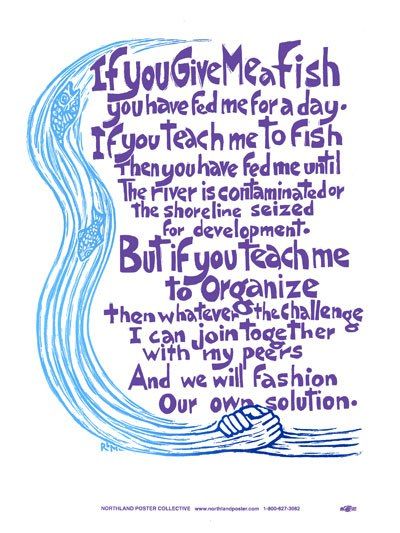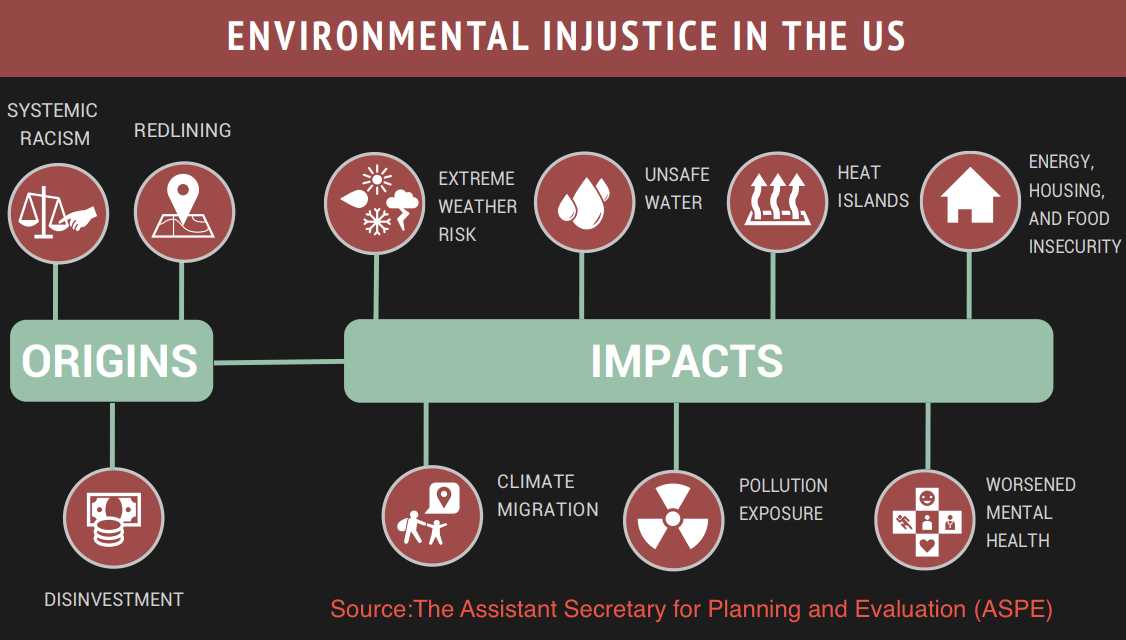Environmental Injustice Examples

Environmental injustice refers to the disproportionate burden of environmental hazards and pollution borne by marginalized communities, often resulting from systemic inequalities and discriminatory practices. These communities, including people of color, low-income groups, indigenous peoples, and other vulnerable populations, face significant health risks and social disadvantages due to their exposure to toxic substances and environmental degradation.
This issue has gained significant attention in recent years as researchers, activists, and policymakers strive to address the root causes and advocate for equitable environmental policies. By examining specific examples of environmental injustice, we can better understand the complex interplay between social, economic, and environmental factors that contribute to these disparities.
Flint Water Crisis: A Devastating Example of Environmental Racism

The Flint Water Crisis, which began in 2014, stands as a poignant illustration of environmental injustice and its devastating consequences. This crisis, which unfolded in Flint, Michigan, highlighted the alarming disparities in access to clean water and the profound health impacts that can result from contaminated water supplies.
In April 2014, Flint, facing financial constraints, switched its water source from the treated Detroit Water and Sewerage Department system to the Flint River as a cost-saving measure. However, this decision proved catastrophic, as the Flint River water was highly corrosive and not adequately treated. As a result, lead from the city's aging water pipes leached into the water supply, exposing residents to dangerously high levels of this toxic metal.
The impact of this contamination was felt most acutely by the city's predominantly African American and low-income residents. Lead exposure can cause severe health issues, particularly in children, including developmental delays, behavioral problems, and permanent neurological damage. Despite numerous complaints and mounting evidence of the water's toxicity, officials failed to take immediate action, leaving the community exposed to this dangerous element for over a year.
The crisis gained national attention in 2015 when local doctors began reporting increased levels of lead in the blood of Flint's children. This sparked a public health emergency, with residents calling for immediate action to address the contaminated water supply. The state eventually acknowledged the crisis and took steps to reconnect Flint to the Detroit water system, but the damage had already been done.
The Flint Water Crisis serves as a stark reminder of the deep-rooted environmental injustices that persist in the United States. It underscores the urgent need for equitable environmental policies and practices that protect the health and well-being of all communities, regardless of their socioeconomic status or racial background.
Lessons Learned and Ongoing Advocacy
In the aftermath of the Flint Water Crisis, several key lessons emerged that have informed ongoing advocacy efforts and policy changes:
- Strengthening Water Quality Monitoring and Regulation: The crisis highlighted the need for stricter water quality monitoring and enforcement of regulations. Since then, there has been a push for more robust testing protocols and increased funding for water infrastructure improvements, particularly in communities at risk of similar crises.
- Addressing Environmental Racism: The disproportionate impact of the water crisis on Flint's African American community brought attention to the issue of environmental racism. This has led to a greater focus on understanding and addressing the systemic inequalities that contribute to environmental injustices.
- Community Engagement and Empowerment: The role of community members in identifying and advocating for solutions cannot be overstated. The Flint Water Crisis inspired a movement of citizen scientists and community organizers who continue to fight for environmental justice and hold government officials accountable.
- Improved Communication and Transparency: The lack of timely and transparent communication from officials during the crisis eroded public trust. Moving forward, there is a greater emphasis on open dialogue and collaboration between government agencies, scientists, and community members to ensure effective crisis management and prevention.
While the Flint Water Crisis was a tragic event, it has also become a catalyst for positive change, spurring legislative reforms, increased public awareness, and a renewed commitment to environmental justice.
Cancer Alley: A Toxic Legacy of Industrial Pollution

Situated along the Mississippi River between New Orleans and Baton Rouge, Louisiana, Cancer Alley is a 85-mile stretch of land that has become synonymous with environmental injustice and its dire health consequences.
This region, officially known as the Louisiana Chemical Corridor, is home to over 150 industrial facilities, including refineries, petrochemical plants, and chemical manufacturers. These industries have contributed significantly to the local economy, but their presence has also led to severe environmental pollution and a disproportionately high incidence of cancer and other health issues among residents.
The term "Cancer Alley" was coined in the 1980s by local activists and residents who noticed an alarming trend: an unusually high number of cancer cases and other health problems within the community. The area's industrial activities release a multitude of toxic substances into the air, water, and soil, including benzene, formaldehyde, and various heavy metals. These pollutants have been linked to an increased risk of respiratory diseases, cardiovascular issues, and several types of cancer.
The communities along Cancer Alley are predominantly African American and low-income, making them especially vulnerable to the health impacts of industrial pollution. Despite numerous studies highlighting the health risks and calls for stricter environmental regulations, the region continues to bear the brunt of industrial pollution, with new facilities and expansions being approved despite community opposition.
Advocacy and Resistance
In response to the environmental and health injustices in Cancer Alley, local residents and activists have formed grassroots movements to demand change. These efforts have included protests, legal challenges, and the establishment of community organizations dedicated to environmental justice and health advocacy.
One notable example is the work of the Louisiana Bucket Brigade, an environmental justice organization that provides tools and resources to communities impacted by industrial pollution. They have developed a system for residents to monitor and report toxic releases, helping to build a body of evidence that supports regulatory action and holds industries accountable.
Additionally, community leaders have successfully advocated for the establishment of health clinics and the expansion of healthcare services in the region. These efforts aim to mitigate the health impacts of environmental pollution and provide much-needed support to residents who have borne the brunt of industrial activities.
The Dangers of Urban Heat Islands and Climate Change
Urban heat islands are metropolitan areas that experience significantly higher temperatures compared to surrounding rural areas due to human activities and the urban environment. This phenomenon, exacerbated by climate change, poses a unique environmental justice challenge, as it disproportionately affects vulnerable populations living in cities.
The urban heat island effect occurs when buildings, roads, and other infrastructure absorb and retain heat, leading to elevated temperatures, particularly during the summer months. This can result in a range of health issues, including heat stroke, dehydration, and respiratory problems, especially for those who are already at risk due to age, pre-existing health conditions, or lack of access to cooling resources.
Low-income communities and communities of color are often disproportionately affected by urban heat islands. These neighborhoods tend to have fewer trees and green spaces, which can help mitigate the heat, and may also have higher concentrations of heat-absorbing materials like concrete and asphalt. Additionally, these communities may face barriers to accessing air conditioning or other cooling measures, further exacerbating the health risks.
Addressing the Urban Heat Island Effect
Addressing the environmental justice concerns posed by urban heat islands requires a multi-faceted approach that involves both mitigation and adaptation strategies:
- Green Infrastructure: Increasing the amount of green space and vegetation in cities can help reduce the urban heat island effect. This includes initiatives like urban forestry, green roofs, and cool pavements, which reflect sunlight and reduce the absorption of heat.
- Energy Efficiency and Cool Roofs: Encouraging energy-efficient building practices and the use of reflective roofing materials can help reduce the heat load in buildings, making them more comfortable and less reliant on air conditioning.
- Community Resilience and Adaptation: Providing resources and education to vulnerable communities can help them better prepare for and cope with extreme heat events. This may include distributing cooling devices, establishing cooling centers, and developing heat emergency response plans.
- Policy and Regulatory Changes: Advocating for policies that prioritize environmental justice and climate resilience can lead to systemic changes. This includes urban planning that considers heat risks, as well as regulations to reduce heat-trapping emissions and promote sustainable development practices.
By addressing the urban heat island effect through these strategies, cities can work towards creating a more equitable and resilient urban environment, ensuring that all residents have the opportunity to thrive despite the challenges posed by climate change.
The Impact of Air Pollution on Vulnerable Communities
Air pollution is a pervasive environmental issue that affects communities worldwide, but its impact is not evenly distributed. Vulnerable populations, including low-income communities, communities of color, and those living near industrial facilities, often bear the brunt of this pollution, leading to serious health consequences and environmental injustices.
Air pollution is a complex mixture of pollutants, including particulate matter, nitrogen dioxide, sulfur dioxide, and volatile organic compounds, among others. These pollutants can come from a variety of sources, such as vehicle emissions, industrial processes, power generation, and household activities. Prolonged exposure to these pollutants has been linked to a range of health issues, including respiratory diseases, cardiovascular problems, and even increased risk of premature death.
Disparities in Exposure and Health Outcomes
Studies have consistently shown that certain communities are disproportionately exposed to air pollution, often due to systemic inequalities and discriminatory practices. For instance, low-income neighborhoods and communities of color are more likely to be located near major highways, industrial sites, and other sources of air pollution. This proximity increases their exposure to toxic pollutants, leading to higher rates of respiratory illnesses, asthma, and other health complications.
The health impacts of air pollution are not limited to respiratory issues. Research has also linked air pollution to increased rates of cardiovascular disease, cognitive impairment, and even adverse birth outcomes. These health disparities contribute to reduced life expectancy and increased healthcare costs for vulnerable communities, further exacerbating existing social and economic inequalities.
Addressing Air Pollution Disparities
Addressing the environmental injustices associated with air pollution requires a multi-faceted approach that targets both the sources of pollution and the systemic inequalities that contribute to disproportionate exposure:
- Strengthening Emissions Regulations: Implementing and enforcing stricter emissions standards for vehicles, industries, and power plants can help reduce overall air pollution levels, particularly in vulnerable communities.
- Promoting Clean Energy and Transportation: Encouraging the adoption of renewable energy sources and promoting public transportation and electric vehicles can help reduce reliance on fossil fuels and decrease air pollution emissions.
- Community Engagement and Monitoring: Involving affected communities in decision-making processes and providing resources for local air quality monitoring can empower residents to advocate for cleaner air and hold polluters accountable.
- Healthcare Access and Support: Ensuring that vulnerable communities have access to quality healthcare and providing support for those suffering from pollution-related health issues can help mitigate the impact of air pollution on these populations.
By addressing the root causes of air pollution disparities and working towards more equitable environmental policies, we can strive for a future where all communities have the opportunity to breathe clean air and thrive without the burden of environmental injustices.
Conclusion: Advancing Environmental Justice Through Action and Awareness

The examples of environmental injustice highlighted here - from the Flint Water Crisis to the toxic legacy of Cancer Alley and the dangers of urban heat islands - demonstrate the urgent need for equitable environmental policies and practices. These cases illustrate how marginalized communities often bear the brunt of environmental hazards and pollution, leading to severe health risks and social disadvantages.
Addressing environmental injustice requires a comprehensive approach that tackles the root causes of these disparities. This includes strengthening environmental regulations, promoting community engagement and empowerment, and advocating for policies that prioritize the health and well-being of all communities. By learning from these examples and taking action, we can work towards a more sustainable and just future where everyone has the right to a clean and healthy environment.
It is crucial to continue raising awareness about environmental injustices and their far-reaching impacts. Through education, advocacy, and collective action, we can foster a society that values environmental justice and ensures that all individuals, regardless of their background or socioeconomic status, have the opportunity to thrive in a healthy and sustainable environment.
FAQ
What is environmental injustice, and why is it important to address it?
+Environmental injustice refers to the disproportionate burden of environmental hazards and pollution borne by marginalized communities. It is important to address because it contributes to health disparities, social inequalities, and a lack of access to a clean and healthy environment for certain populations. By tackling environmental injustice, we can work towards a more equitable and sustainable society.
How does the Flint Water Crisis illustrate environmental injustice?
+The Flint Water Crisis is a prime example of environmental injustice. The decision to switch Flint’s water source, coupled with inadequate treatment and a lack of timely action, led to the exposure of predominantly African American and low-income residents to dangerous levels of lead. This crisis highlights the deep-rooted environmental inequalities that persist in the United States and the urgent need for equitable environmental policies.
What are the main causes of environmental injustice in Cancer Alley, Louisiana?
+Cancer Alley, or the Louisiana Chemical Corridor, is home to numerous industrial facilities that release toxic pollutants into the air, water, and soil. The disproportionate impact on predominantly African American and low-income communities is due to the concentration of these industries in the region, leading to severe environmental pollution and an increased risk of cancer and other health issues.
How do urban heat islands contribute to environmental injustice in cities?
+Urban heat islands, areas with significantly higher temperatures due to human activities and the urban environment, disproportionately affect vulnerable populations, including low-income communities and communities of color. These areas often have fewer green spaces and cooling resources, leading to increased health risks during extreme heat events. Addressing urban heat islands is crucial for creating a more equitable and resilient urban environment.



